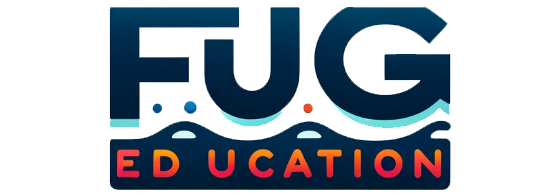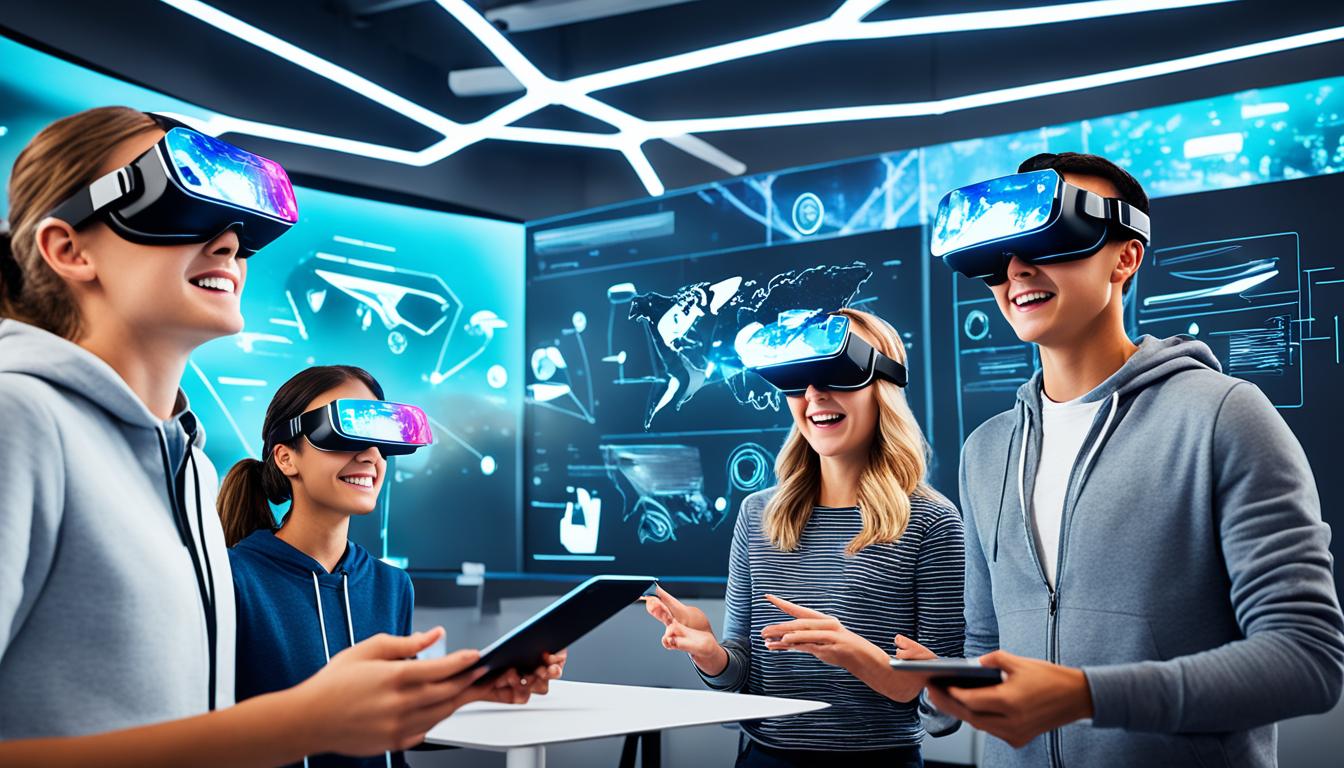Virtual learning has undergone a significant transformation in recent years, thanks to the implementation of innovative technology trends in education. This article will explore the latest advancements and digital learning solutions that have reshaped the landscape of education. From comprehensive platforms for remote education to personalized learning experiences through AI and immersive learning environments using virtual reality, the possibilities for virtual learning have expanded greatly. These innovations have brought about a paradigm shift in the way education is delivered and experienced, offering new opportunities for both students and educators.
Key Takeaways:
- Innovative technology trends have revolutionized virtual learning in education.
- Comprehensive platforms for remote education provide accessible and interactive learning experiences.
- Personalized learning through AI improves student engagement and outcomes.
- Virtual reality creates immersive learning environments, enhancing student understanding and retention.
- Technology integration in education has transformed traditional teaching methods, leading to more effective and engaging classrooms.
Exploring the Landscape of Digital Learning Solutions
Digital learning solutions have become an essential component of modern education. As the world embraces technology, comprehensive platforms have been developed to facilitate remote education, providing students with the ability to access their coursework and interact with their teachers and peers from anywhere in the world.
Comprehensive platforms for remote education integrate various tools and resources to deliver a seamless virtual learning experience. These platforms offer a wide range of features including video conferencing, interactive learning materials, real-time collaboration, and assessment tools. Students can engage with their coursework, participate in discussions, submit assignments, and receive feedback, all accessible through these comprehensive platforms.
One of the key advantages of these comprehensive platforms is their ability to provide personalized learning experiences through the use of artificial intelligence (AI). AI algorithms analyze vast amounts of data to tailor educational content and assessments to the unique needs and learning styles of individual students. This personalized approach promotes greater engagement and comprehension, leading to enhanced learning outcomes.
Additionally, virtual reality (VR) has emerged as a powerful tool for creating immersive learning environments. Through virtual simulations, students can explore and interact with realistic and dynamic virtual worlds, allowing for hands-on experiences that deepen their understanding of complex concepts. Virtual reality in education opens up new possibilities for experiential learning, fostering creativity, critical thinking, and problem-solving skills.
Comprehensive Platforms for Remote Education
Comprehensive platforms for remote education have revolutionized the way students and educators engage in virtual learning. These platforms bring together various features and tools under one unified interface, creating a seamless and efficient learning experience. From live video conferencing and screen sharing to document collaboration and online assessments, these platforms enable educators to deliver engaging and interactive lessons while students can actively participate in discussions and access learning materials.
Personalized Learning Experiences through AI
Artificial intelligence (AI) is transforming education by enabling personalized learning experiences. AI algorithms analyze student data, such as performance, learning styles, and preferences, to tailor educational content and assessments to the individual needs of each student. Through adaptive learning technologies, students receive targeted recommendations and support, allowing them to learn at their own pace and focus on areas where they need improvement. This personalized approach fosters a deeper understanding of the subject matter and promotes student success.
Virtual Reality: Immersive Learning Environments
Virtual reality (VR) technology has the potential to revolutionize the way students learn by creating immersive learning environments. Through VR simulations, students can engage in realistic and interactive experiences that enhance their understanding of complex concepts. Whether exploring the depths of the ocean or dissecting a virtual specimen, virtual reality brings learning to life and sparks curiosity and engagement. By providing hands-on experiences in a virtual world, VR enables students to develop critical thinking, problem-solving, and decision-making skills in a safe and controlled environment.
| Benefits of Comprehensive Platforms for Remote Education | Advantages of Personalized Learning through AI | Benefits of Virtual Reality in Education |
|---|---|---|
| Enables access to education from anywhere | Tailors education to individual student’s needs | Creates immersive and interactive learning experiences |
| Promotes collaboration and interaction among students and teachers | Enhances student engagement and motivation | Fosters deeper understanding of complex concepts |
| Provides a wide range of tools and resources for effective teaching and learning | Supports personalized feedback and assessment | Develops critical thinking and problem-solving skills |
The Role of Big Data in Personalizing Student Learning
In the era of digital education, big data has emerged as a powerful tool for personalizing student learning. By leveraging the vast amount of data collected from students, educators can gain valuable insights into their individual strengths, weaknesses, and learning patterns. This data-driven approach allows for the development of adaptive learning technologies that provide tailored learning experiences, maximizing student engagement and academic success.
Adaptive Learning Technologies
Adaptive learning technologies are a direct result of harnessing the power of big data in education. These technologies use algorithms and analytics to track and analyze student performance, enabling educators to design personalized learning pathways. By continuously refining and adapting these pathways based on real-time feedback, adaptive learning technologies cater to each student’s unique needs and learning pace. This approach promotes self-paced learning, ensures mastery of content, and improves overall learning outcomes.
Data Privacy and Ethical Considerations
While the utilization of big data in education holds immense potential, it also raises important concerns regarding data privacy and ethical considerations. Safeguarding student data is a top priority, requiring robust security measures and strict adherence to data protection regulations. Educational institutions must ensure transparent data collection practices, obtain explicit consent from students, and maintain high standards of data governance. Additionally, ethical considerations such as data anonymization and informed data usage must be carefully addressed to maintain trust and confidence in the educational system.
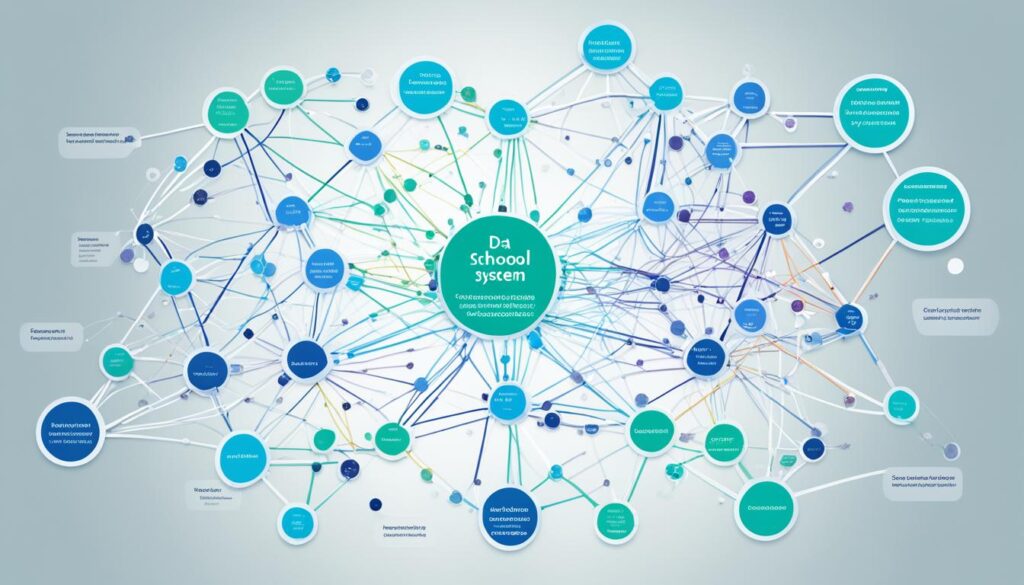
| Benefits of Big Data in Personalizing Student Learning | Challenges and Ethical Considerations |
|---|---|
|
|
Innovative Teaching Methods Using Technology
Technology has revolutionized the field of education, paving the way for innovative teaching methods that engage students and enhance their learning experience. Educators can now leverage various technological tools and resources to create interactive and dynamic lessons, transforming traditional classrooms into dynamic learning environments.
“Technology plays a significant role in modern education, allowing educators to explore new horizons and engage students in ways that were not possible before.”
One of the key benefits of incorporating technology in education is the ability to deliver multimedia presentations. Multimedia presentations, such as videos and interactive slideshows, enable educators to present complex concepts in a visually appealing and engaging manner. This helps students grasp and retain information more effectively.
Furthermore, online collaboration platforms have revolutionized the way students work together on projects and assignments. These platforms allow students to collaborate in real-time, regardless of their physical location, fostering teamwork and critical thinking skills. By working collaboratively, students learn from each other’s perspectives, expanding their knowledge and promoting a sense of community within the classroom.
Gamification is another innovative teaching method that technology has made possible. By incorporating game elements, such as rewards and challenges, into the learning process, educators can motivate students to actively participate and stay engaged. Gamification not only makes learning more enjoyable but also encourages students to develop problem-solving skills and think critically to overcome obstacles.
Virtual simulations have also revolutionized the way students learn and explore complex subjects. Through virtual reality (VR) and augmented reality (AR) technologies, students can immerse themselves in realistic simulations that replicate real-world scenarios. This hands-on approach enhances their understanding and enables them to apply their knowledge in practical ways.
“Technology-driven teaching methods promote active learning, critical thinking, and problem-solving skills, making the educational process more engaging and effective.”
By incorporating these innovative teaching methods, educators can create interactive learning experiences that foster curiosity, creativity, and a deeper understanding of the subject matter. These methods promote active learning, critical thinking, and problem-solving skills, giving students the skills they need to succeed in the modern world.
Cutting-edge Learning Tools for Collaborative Education
Collaborative education is a key aspect of modern learning environments, fostering peer-to-peer interaction and promoting effective knowledge sharing. To facilitate collaborative learning experiences, cutting-edge learning tools have been developed, providing educators and students with innovative ways to collaborate both inside and outside the classroom.
The Rise of Learning Management Systems (LMS)
One of the fundamental tools for collaborative education is the Learning Management System (LMS). LMS platforms have revolutionized the way educational institutions manage and deliver courses. With features such as online discussions, file sharing, and real-time feedback, LMS platforms enable educators and students to engage in collaborative learning experiences regardless of their physical location.
LMS platforms offer a centralized hub where learning materials, assignments, and grades can be accessed, ensuring that students have easy and organized access to course content. They also provide tools for online assessments, which streamline the evaluation process, allowing educators to provide timely feedback and monitor student progress effectively.
Enhancing Peer-to-Peer Interaction with Tech Tools
In addition to LMS platforms, there are various tech tools available that enhance peer-to-peer interaction and collaboration in educational settings. These tools promote active engagement and encourage students to work together to solve problems, share ideas, and develop critical thinking skills.
“Collaboration is key to fostering innovative thinking and preparing students for the collaborative nature of the modern workplace.” – Dr. Sarah Johnson, Education Consultant
- Online Collaboration Platforms: These platforms provide virtual spaces where students can collaborate on projects, share ideas, and provide feedback to their peers. They offer features such as document sharing, real-time editing, and discussion boards, facilitating seamless collaboration even when learners are not physically present in the same location.
- Video Conferencing Tools: Video conferencing tools have become essential for remote collaboration, allowing students to connect and interact in real-time. These tools enable face-to-face discussions, presentations, and group work, fostering communication and teamwork skills.
- Virtual Whiteboards: Virtual whiteboards simulate physical whiteboards, allowing multiple users to contribute and collaborate simultaneously. They can be used for brainstorming sessions, problem-solving activities, and visualizing concepts, promoting active participation and creativity.
By leveraging these cutting-edge learning tools, educators can create an interactive and collaborative learning environment that empowers students to take an active role in their education. As technology continues to advance, the possibilities for collaborative education will continue to expand, providing new opportunities for students to connect, learn, and grow together.
EdTech Breakthroughs in Assessing Student Performance
Assessing student performance has taken a significant leap forward with the integration of educational technology (EdTech) breakthroughs. These innovative advancements have revolutionized traditional assessment methods, providing educators with powerful tools to gauge student achievement and provide real-time feedback. Additionally, these technologies address concerns of fairness in assessment and enable adaptive assessments that cater to individual learning needs.
Real-Time Feedback and Adaptive Assessments
One of the standout features of EdTech breakthroughs in assessing student performance is the ability to provide real-time feedback. Gone are the days of waiting for weeks to receive evaluation results. With the help of technology, students can now receive immediate feedback on their performance, allowing them to identify areas of improvement and make necessary adjustments in a timely manner. This real-time feedback fosters a continuous learning process, empowering students to take ownership of their educational journey.
Furthermore, adaptive assessments have emerged as a game-changer in student evaluations. Leveraging the power of artificial intelligence (AI), these assessments dynamically adjust the difficulty and content based on individual student capabilities. By adapting to each student’s unique learning needs, adaptive assessments offer a personalized assessment experience that goes beyond a one-size-fits-all approach. This tailored approach promotes student engagement and ensures that students are appropriately challenged, ultimately leading to a more accurate representation of their abilities.
Technology in Standardized Testing and Fairness
EdTech has also made significant inroads in the realm of standardized testing, addressing long-standing concerns of fairness and equity. Standardized tests are essential for evaluating student performance on a larger scale, but they often face scrutiny due to factors such as bias and limited representation of diverse student populations. To overcome these challenges, technology has been incorporated into standardized testing processes to reduce biases and establish a level playing field.
Technological advancements in assessment have paved the way for more inclusive and fair standardized testing. For example, AI-powered algorithms can analyze student responses and identify potential biases or discrepancies, ensuring that assessments are as objective as possible. Similarly, the integration of technology can provide accommodations for students with special needs, creating a more accessible testing environment for all students. These efforts contribute to the goal of ensuring fairness in assessment and providing accurate representations of student abilities.
In summary, EdTech breakthroughs in assessing student performance have transformed the way educators evaluate and provide feedback. Real-time feedback and adaptive assessments empower students to track their progress and tailor their learning journey, while technology in standardized testing enhances fairness and equity. As technology continues to advance, the ability to assess student performance effectively and fairly will only improve, fostering a more inclusive and data-driven educational landscape.

Innovations in Education Technology
Innovations in education technology have revolutionized the way education is delivered and experienced. With continuous advancements in technology, educators and students now have access to a wide range of innovative tools and resources that enhance the educational process.
One prominent innovation in education technology is the implementation of AI-powered learning platforms. These platforms leverage artificial intelligence to provide personalized learning experiences tailored to individual students’ needs. By analyzing data and adapting content in real-time, AI-powered platforms offer students a more personalized and effective learning journey.
In addition to AI, emerging technologies like augmented reality (AR) have also made a significant impact on education. AR applications create immersive learning environments that bring abstract concepts to life and enhance student engagement. Through interactive simulations and virtual experiences, students can explore complex subjects in a more tangible and interactive way.
The integration of emerging technologies in education has paved the way for modernizing education with technology. These innovations not only facilitate interactive and engaging learning experiences but also equip students with the digital skills and competencies they need to thrive in the modern world.
As technology continues to advance, the future of education holds boundless possibilities. From AI-powered platforms to immersive virtual reality applications, innovations in education technology will continue to shape the future of learning, providing educators and students with exciting tools and resources to enhance the educational experience.
Integrating Emerging Technologies in Classroom Settings
As education continues to evolve, integrating emerging technologies in classroom settings has the potential to revolutionize traditional teaching methods. By embracing the latest technological advancements, educators can create a more dynamic and engaging learning environment for students. Two key areas of focus in this regard are the Internet of Things (IoT) for smarter classrooms and the implications of wearable devices in learning.
The Internet of Things (IoT) for Smarter Classrooms
The Internet of Things (IoT) offers exciting opportunities for creating smarter classrooms. By connecting devices and equipment to the internet, educators can harness the power of real-time monitoring, data collection, and analysis to enhance the learning experience. IoT-enabled devices can provide personalized recommendations, track student progress, and automate administrative tasks, allowing teachers to focus more on individualized instruction and student engagement.
Wearable Devices and Their Implications for Learning
Wearable devices, such as smartwatches and fitness trackers, have gained popularity in recent years. These devices have the potential to transform the learning experience by augmenting classroom activities and providing valuable data insights. Wearable devices can track students’ physical activity, heart rate, and sleep patterns, offering educators a deeper understanding of each student’s wellbeing. With this information, teachers can tailor their instruction to better support students’ physical and mental health, ultimately leading to improved learning outcomes.
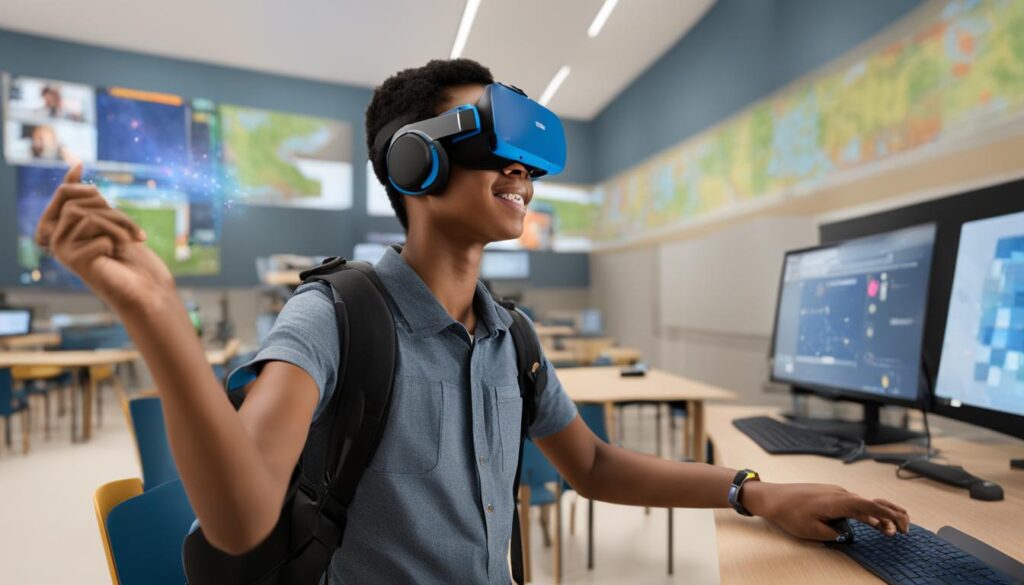
“Integrating emerging technologies in the classroom opens up new avenues for personalized learning and data-driven instruction.”
By fostering a learning environment where emerging technologies are seamlessly integrated, educators can leverage the power of the IoT and wearable devices to enhance student engagement, personalize learning experiences, and improve overall educational outcomes. As technology continues to evolve, the possibilities for integrating emerging technologies in the classroom are endless, ushering in an era of innovation and transformation in education.
New Trends in EdTech and the Future of Learning
Staying ahead of the curve in education technology requires continuous innovation. As the landscape of education continues to evolve, educators and institutions need to embrace new trends in edtech to enhance the learning experience for students and prepare them for the future.
Staying Ahead of the Curve with Continuous Innovation
Continuous innovation is essential to keep up with the ever-changing demands of the educational landscape. Embracing emerging technologies and integrating them into the classroom can lead to exciting breakthroughs in teaching and learning. Adaptive learning algorithms, for example, use artificial intelligence to personalize the learning experience, tailoring content and instruction to individual students’ needs and preferences.
“Continuous innovation in education technology is vital for creating engaging and effective learning environments. By staying abreast of the latest trends and advancements, educators can provide students with transformative educational experiences.”
Blockchain in education is another exciting trend that holds immense potential. This technology can increase transparency, security, and efficiency in areas such as credentialing and student records. It has the power to revolutionize the way educational data is stored, verified, and shared, ensuring trust and credibility in the digital age.
Virtual and augmented reality applications are also transforming the future of learning. These immersive technologies enable students to experience virtual environments, engage in simulations, and explore complex concepts in a more interactive and engaging way. From virtual field trips to hands-on science experiments, these technologies have the ability to enhance comprehension and foster deeper learning.
Sustainable Tech and Green Computing in Education
As technology becomes an integral part of the learning process, it is crucial to consider sustainability and environmental impact. Green computing practices that prioritize energy efficiency and reduce electronic waste are vital for creating a more sustainable future in education.
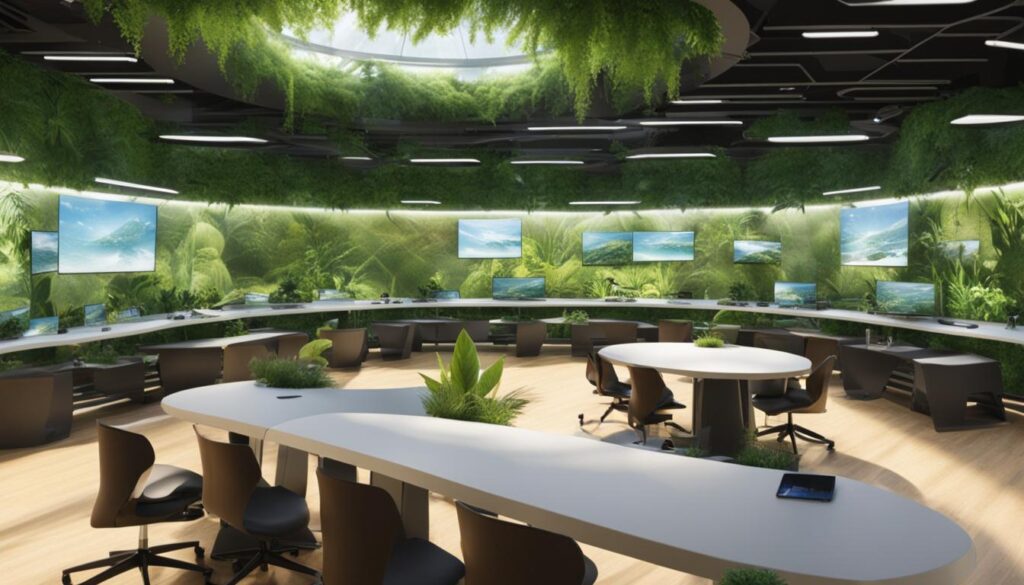
By utilizing energy-efficient devices and optimizing power consumption, educational institutions can minimize their carbon footprint. Additionally, promoting responsible e-waste management by recycling and disposing of electronic devices responsibly helps to mitigate the environmental impact of technology in education.
“Incorporating sustainability practices into edtech not only benefits the environment but also instills in students a sense of environmental responsibility, fostering a collective effort towards a greener future.”
Incorporating sustainability education into the curriculum can also raise awareness among students about the importance of environmental stewardship. By teaching them about green computing and the impact of technology on the environment, educators can empower the next generation to become responsible digital citizens.
| New Trends in EdTech | Impact on the Future of Learning |
|---|---|
| Adaptive learning algorithms | Personalized learning experiences |
| Blockchain in education | Increased transparency and security in student records |
| Virtual and augmented reality applications | Immersive and interactive learning experiences |
| Sustainable tech and green computing | A more environmentally conscious approach to education |
Technology-Driven Classroom Innovations and Student Engagement
Technology has revolutionized the educational landscape, offering innovative solutions to increase student engagement and motivation. By incorporating technology-driven classroom innovations, educators can create interactive learning experiences that captivate students’ attention and enhance their overall learning outcomes.
One of the key benefits of technology in the classroom is the ability to provide interactive learning experiences. With the use of edtech tools, instructors can create engaging activities that encourage active participation and critical thinking. These interactive experiences enable students to explore educational content in a dynamic and immersive manner, fostering a deeper understanding of the subject matter.
Gamification is another strategy that utilizes technology to promote student engagement. By incorporating game elements and mechanics into the learning process, educators can transform traditional lessons into exciting and challenging experiences. Gamified learning experiences motivate students to achieve goals, earn rewards, and compete with their peers, making the educational journey more enjoyable and meaningful.
Furthermore, multimedia resources such as videos, animations, and virtual reality simulations can enhance student engagement and comprehension. These visual and immersive tools enable students to visualize complex concepts, making learning more accessible and memorable. For example, virtual reality can transport students to historical events, scientific phenomena, or even foreign countries, allowing them to explore and experience these subjects firsthand.
Additionally, technology facilitates differentiated instruction, accommodating students with diverse learning styles and preferences. Edtech tools enable educators to customize learning materials and activities, catering to individual needs and promoting personalized learning experiences. By providing tailored instruction, students can engage with content at their own pace and explore topics that align with their interests, ultimately enhancing their motivation and academic performance.
Ultimately, technology-driven classroom innovations play a vital role in increasing student engagement and motivation. By incorporating interactive learning experiences, gamification, multimedia resources, and differentiated instruction, educators can create a dynamic and stimulating learning environment that fosters student success.
“Technology will never replace great teachers, but technology in the hands of great teachers is transformational.” – George Couros
Conclusion
Innovation in education technology has revolutionized the way education is delivered and experienced. The advancements in digital learning solutions, AI-powered personalized learning experiences, and emerging technologies have transformed classrooms worldwide. By integrating technology into education, educators have been able to facilitate collaborative learning, provide personalized instruction, and increase student engagement.
The use of cutting-edge tools for learning, such as comprehensive platforms for remote education, adaptive learning technologies, and immersive learning environments through virtual reality, has created a more inclusive and effective learning environment. These innovations have modernized education and opened up new possibilities for educators and students alike.
As technology continues to evolve, the future of education is filled with limitless potential. The continuous development and implementation of innovative teaching methods using technology, along with advancements in educational technology, will shape the future of learning. By harnessing the power of technology, educators can transform education and provide students with the skills and knowledge necessary for success in the modern world.”
FAQ
What are some cutting-edge tools for learning?
Some cutting-edge tools for learning include AI-powered learning platforms, virtual reality applications, and interactive multimedia resources.
How do digital learning solutions enhance education?
Digital learning solutions provide remote education opportunities, personalized learning experiences, and access to a wide range of educational resources.
What are some emerging technologies in education?
Emerging technologies in education include the Internet of Things (IoT), wearable devices, and augmented reality applications.
How can technology be integrated into the classroom?
Technology can be integrated into the classroom through the use of interactive whiteboards, online collaboration platforms, and educational apps and software.
What are some innovative teaching methods using technology?
Some innovative teaching methods using technology include gamification, multimedia presentations, and virtual simulations.
